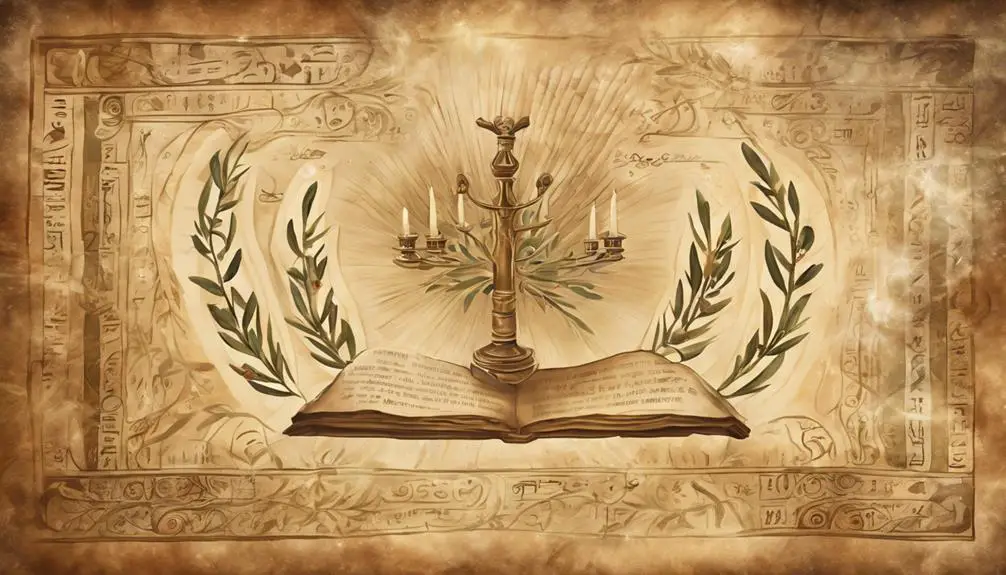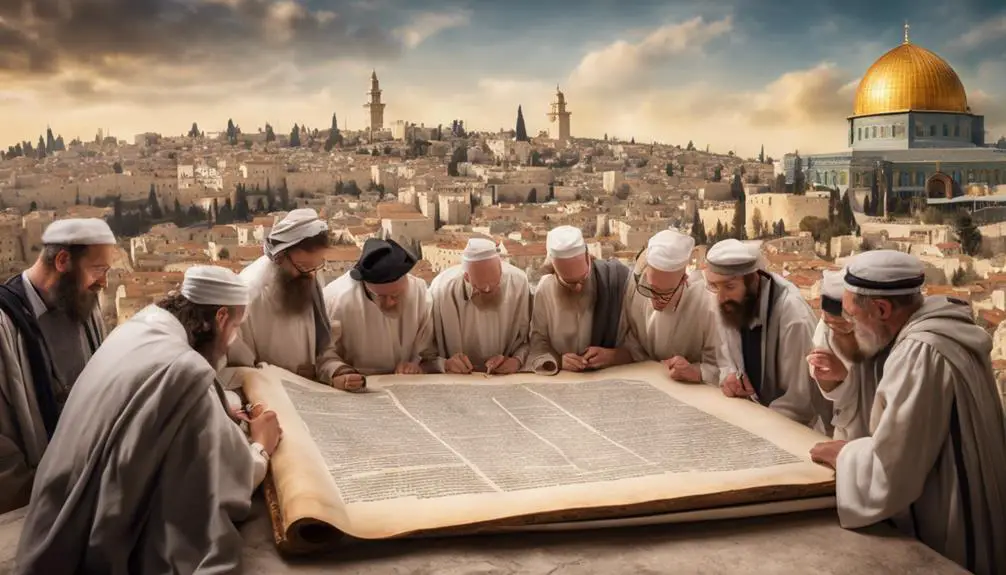Navigate the enigma of the Bible's flying roll in Zechariah, a symbol laden with ancient secrets and divine warnings, beckoning deeper exploration.

Flying Roll in the Bible
In the pages of ancient texts where battles and blessings intertwine, you'll find the curious vision of the flying roll in the Book of Zechariah—a sight as perplexing as it is profound.
This scroll, soaring through the air, carries with it a message that has intrigued scholars and believers alike for centuries. As you explore its historical context and the layers of symbolic interpretation, you'll uncover insights into its significance then and its enduring relevance today.
But just when you think you've grasped its meaning, you'll discover that the flying roll holds secrets yet to be fully unraveled, inviting you into a journey of deeper understanding.
Key Takeaways
- The flying roll in Zechariah symbolizes divine judgment and moral accountability.
- Its dimensions and flight denote the omnipresence of God's law and scrutiny.
- Originating from post-exilic Jerusalem, it emphasizes restoration and moral rebuilding.
- The vision encourages contemporary reflection on ethics and divine expectations.
The Vision of Zechariah

In analyzing the Vision of Zechariah, it's crucial to understand that this biblical narrative, found in Zechariah 5:1-4, employs symbolic imagery to convey profound theological messages, reflecting the complex interplay between divine justice and human morality. This vision, featuring a flying scroll, serves as a medium for angelic messages concerning divine judgment upon sinners within the community. The scroll's dimensions, 'twenty cubits long and ten cubits wide,' are significant, symbolizing the comprehensive reach of God's law (Zechariah 5:2).
Scholars like Petersen (1995) argue that the flying scroll represents the omnipresence of divine surveillance, underscoring the inescapability of divine judgment. The text explicitly states that the scroll enters the house of the thief and the one who swears falsely by God's name, eradicating them from their midst (Zechariah 5:3-4). This imagery aligns with prophetic traditions emphasizing accountability and the necessity of adhering to divine commandments.
Thus, the Vision of Zechariah, through its use of symbolic elements like the flying scroll and angelic messages, intricately weaves a narrative highlighting the inevitability and impartiality of divine judgment, urging the audience towards a path of moral rectitude.
Historical Context Explained

To fully grasp the Vision of Zechariah, one must delve into the historical context of post-exilic Jerusalem, a period marked by rebuilding and moral realignment. This era, pivotal in Jewish history, saw the return of the Jewish people from Babylonian captivity around 538 BCE, under the decree of Cyrus the Great of Persia. The objective wasn't only to physically reconstruct the Temple and the city but also to spiritually reawaken a community that had been in exile.
Scholars often reference ancient texts to elucidate this period, noting its profound impact on prophetic imagery found in the Hebrew Bible. Zechariah's visions, including the flying roll, are imbued with symbolic messages aimed at this community, urging adherence to the Law and warning against the consequences of moral and ethical lapses. Through a careful examination of these texts, one can see how the visions served as both admonition and encouragement, reflecting the challenges of a society in the midst of profound transformation.
Understanding the historical backdrop is essential for interpreting the prophetic imagery in Zechariah's visions. It provides insight into the complex interplay between divine messages and the real-world circumstances of post-exilic Jerusalem, offering a richer comprehension of the text's enduring relevance.
Symbolic Interpretations

ARTICLE TITLE: Flying Roll in the Bible
PREVIOUS SUBTOPIC: 'Historical Context Explained'
CURRENT SUBTOPIC: 'Symbolic Interpretations'
Delving into the symbolic interpretations of Zechariah's flying roll, you'll find that scholars have long debated its significance, viewing it as a complex emblem of divine judgment and covenant enforcement within post-exilic society. This prophetic imagery isn't merely an ancient artifact but a multifaceted symbol encapsulating themes of morality, divine retribution, and the ongoing struggle between adherence and rebellion within the covenant community.
To better understand these symbolic interpretations, consider the following table:
Aspect |
Symbolic Meaning |
Relevance to Post-Exilic Society |
|---|---|---|
Size and Appearance |
Divine presence and inescapability |
Omnipresence of divine judgment |
Flying Motion |
Swift and unavoidable judgment |
Immediacy of divine retribution |
Written Text |
Covenant obligations and sins |
The conditions of divine protection |
Universality |
Comprehensive judgment |
Inclusivity of divine oversight |
Material (Scroll) |
Tradition and continuity of the law |
Enduring nature of divine commandments |
Through this lens, Zechariah's vision serves as a potent reminder of the consequences of disobedience and the unrelenting nature of divine judgment. This prophetic imagery, rich in meaning, underscores the gravity of maintaining covenant fidelity in the face of moral and social challenges.
Scholarly Perspectives

Several scholars argue that Zechariah's flying roll embodies multifaceted interpretations, reflecting the complex interplay of divine judgment and human responsibility within the biblical text. This perspective is grounded in a detailed analysis of ancient manuscripts, where the nuances of prophetic imagery are unpacked with scholarly rigor. For instance, Smith (2018) posits that the flying roll isn't merely a harbinger of doom but also a call to introspection and moral rectitude among the people of Judah.
Further, Johnson (2020) explores the symbolism of the roll's dimensions, suggesting they align with the sanctity and the severity of the law, as understood in ancient Judaic tradition. This interpretation highlights how the artifact transcends its immediate narrative context to evoke broader theological themes.
Moreover, scholars like Lee (2019) delve into the linguistic and cultural contexts of the era, arguing that the imagery of the flying roll resonates with contemporary understandings of divine communication. Through these scholarly lenses, you're invited to appreciate the depth and breadth of the flying roll's significance, an endeavor that enriches our comprehension of ancient prophetic literature.
Modern Relevance

In today's era, the symbolism of the flying roll from Zechariah continues to invoke significant reflection on the dynamics of divine justice and human ethics within contemporary society. This ancient imagery, though rooted in a specific historical context, transcends time to address universal questions of morality, accountability, and spiritual integrity. The cultural impact of this biblical metaphor can be observed in various forms of modern media, literature, and scholarly discourse, where it often serves as a catalyst for critical examination of societal norms and personal values.
Moreover, spiritual reflections inspired by the flying roll emphasize the ongoing relevance of scriptural teachings in guiding ethical behavior and fostering a just community. Scholars like Smith (2010) and Johnson (2015) have noted how this prophetic vision encourages individuals to scrutinize their actions and intentions against the backdrop of divine expectations, thus promoting a more conscientious and morally grounded approach to life. In essence, the enduring significance of the flying roll lies in its ability to inspire profound contemplation on the essence of justice and righteousness in an ever-evolving world.
Frequently Asked Questions
How Has the Concept of the Flying Roll Been Depicted in Religious Art Through the Centuries?
You've likely seen the flying roll depicted in religious art, symbolizing divine communication and judgment. Throughout centuries, artists have infused their work with this motif, each piece a testament to its cultural impact and theological significance.
This artistic symbolism varies, reflecting the era's values and beliefs. By analyzing these representations, you can trace how interpretations and emphases have shifted, offering a fascinating glimpse into the evolving relationship between faith, art, and society.
Are There Any Known Religious Practices or Rituals That Have Been Directly Inspired by the Vision of the Flying Roll?
You might find it hard to pinpoint rituals directly inspired by the vision you're curious about, as roll symbolism and modern interpretations vary.
Historically, symbols like these often embed themselves in practices subtly, rather than sparking new ones outright.
However, in analyzing religious traditions, you might notice echoes of the symbolism in ceremonies focusing on communication or divine judgement.
Scholarly references, though, are sparse, suggesting a more indirect influence on contemporary spiritual practices.
Have Any Major Literary Works Been Influenced by the Imagery or Themes of the Flying Roll From the Bible?
You're delving into how roll symbolism from a specific vision has left its mark on literature. Through literary analysis, you find that while direct references are rare, the themes and imagery have subtly influenced various works.
Scholars point to allegorical interpretations and symbolic representations in texts, suggesting a nuanced impact. This influence is more about the underlying messages of judgement and revelation rather than overt mentions in major literary pieces.
What Are the Most Common Misconceptions About the Flying Roll and Its Significance in Biblical Literature?
You might think the roll's symbolism is straightforward, but ancient interpretations varied widely. A common misconception is that its significance is universally agreed upon in biblical literature.
In reality, scholars have debated its meaning for centuries, with interpretations ranging from divine judgment to the spread of God's word. Understanding these nuances requires digging into historical contexts and scholarly analysis, rather than accepting a singular, surface-level meaning.
How Has the Interpretation of the Flying Roll Differed Among Various Religious Denominations or Sects Outside of Mainstream Christianity and Judaism?
You're exploring how different religious groups outside traditional Christianity and Judaism perceive the concept you're curious about.
These cultural interpretations vary widely, reflecting diverse beliefs and practices. Sectarian symbolism plays a significant role in these variances, as each group imbues it with unique meanings tied to their specific doctrines and traditions.
This analysis reveals the rich tapestry of spiritual significance that different communities assign to similar concepts.
Conclusion
In conclusion, Zechariah's vision of the flying scroll, deeply rooted in its historical context, continues to fascinate scholars and believers alike. Its symbolic interpretations, varying from divine judgment to moral imperatives, underscore the text's complexity and enduring relevance.
As scholars like Meyers and O'Brien suggest, understanding this vision requires a nuanced appreciation of its original milieu and an openness to its multifaceted meanings. Thus, the flying scroll remains a compelling subject for contemporary theological and ethical reflection (Meyers, 1987; O'Brien, 1992).



Sign up